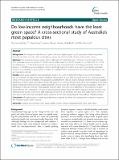Files in this item
Do low-income neighbourhoods have the least green space? : a cross-sectional study of Australia's most populous cities
Item metadata
| dc.contributor.author | Astell-Burt, Thomas | |
| dc.contributor.author | Feng, Xiaoqi | |
| dc.contributor.author | Mavoa, Suzanne | |
| dc.contributor.author | Badland, Hannah M | |
| dc.contributor.author | Giles-Corti, Billie | |
| dc.date.accessioned | 2014-05-16T09:31:03Z | |
| dc.date.available | 2014-05-16T09:31:03Z | |
| dc.date.issued | 2014-03-31 | |
| dc.identifier | 118951545 | |
| dc.identifier | 23654ecc-13e2-4800-95a2-f4088741ed8d | |
| dc.identifier | 24678610 | |
| dc.identifier | 84899678707 | |
| dc.identifier | 000335356700001 | |
| dc.identifier.citation | Astell-Burt , T , Feng , X , Mavoa , S , Badland , H M & Giles-Corti , B 2014 , ' Do low-income neighbourhoods have the least green space? a cross-sectional study of Australia's most populous cities ' , BMC Public Health , vol. 14 , 292 . https://doi.org/10.1186/1471-2458-14-292 | en |
| dc.identifier.issn | 1471-2458 | |
| dc.identifier.uri | https://hdl.handle.net/10023/4811 | |
| dc.description | Funding: Fellowship, National Heart Foundation of Australia. | en |
| dc.description.abstract | An inequitable distribution of parks and other 'green spaces' could exacerbate health inequalities if people on lower incomes, who are already at greater risk of preventable diseases, have poorer access. | |
| dc.format.extent | 11 | |
| dc.format.extent | 1270435 | |
| dc.language.iso | eng | |
| dc.relation.ispartof | BMC Public Health | en |
| dc.subject | Australia | en |
| dc.subject | Environment | en |
| dc.subject | Green space | en |
| dc.subject | Health | en |
| dc.subject | Income | en |
| dc.subject | Inequity | en |
| dc.subject | Neighbourhood | en |
| dc.subject | Public open space | en |
| dc.subject | RA0421 Public health. Hygiene. Preventive Medicine | en |
| dc.subject | SDG 3 - Good Health and Well-being | en |
| dc.subject | SDG 11 - Sustainable Cities and Communities | en |
| dc.subject.lcc | RA0421 | en |
| dc.title | Do low-income neighbourhoods have the least green space? : a cross-sectional study of Australia's most populous cities | en |
| dc.type | Journal article | en |
| dc.contributor.institution | University of St Andrews. School of Geography and Geosciences | en |
| dc.identifier.doi | 10.1186/1471-2458-14-292 | |
| dc.description.status | Peer reviewed | en |
This item appears in the following Collection(s)
Items in the St Andrews Research Repository are protected by copyright, with all rights reserved, unless otherwise indicated.

